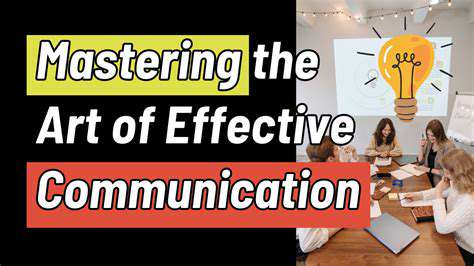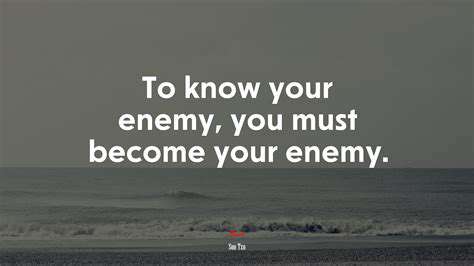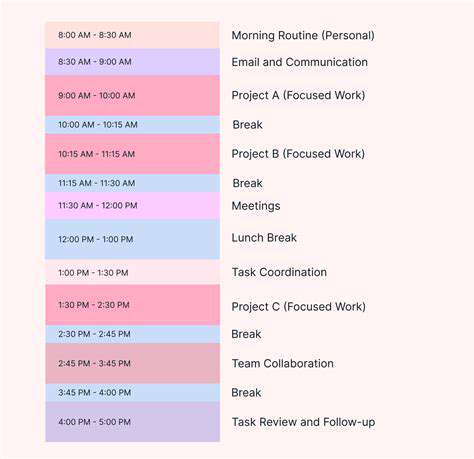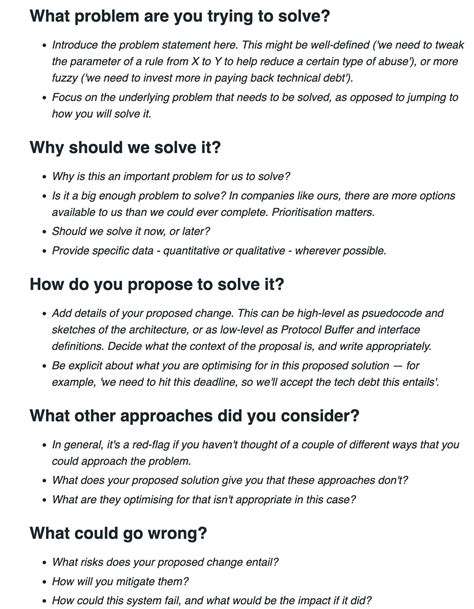Guide to Time Management at Work
Strategies for Minimizing Distractions and Procrastination

Minimizing Visual Distractions
Visual distractions are a significant contributor to reduced focus and productivity. Cluttered workspaces, unnecessary decorations, and excessive screen use can all contribute to this problem. Creating a designated workspace free from clutter and visual noise is a key first step in minimizing these types of distractions. Consider a minimalist aesthetic, ensuring only essential items are present. This focused environment helps your brain settle into a productive mode, reducing the mental effort required to filter out irrelevant stimuli.
Furthermore, strategically positioning your workspace to minimize distractions from external sources like noisy traffic or conversations is crucial. Consider soundproofing or using noise-canceling headphones if possible.
Managing Digital Distractions
In today's digital age, constant notifications and social media updates can be overwhelming and severely disrupt focus. Actively managing your digital environment is essential to minimizing these types of distractions. Using website blockers or app timers is a great technique for limiting access to distracting websites or apps. Scheduling specific times for checking emails, social media, or other digital platforms can also help you maintain your focus on tasks.
Consider turning off notifications or using 'do not disturb' settings during focused work periods.
Prioritizing Tasks and Setting Clear Goals
A lack of clarity about what to do first can lead to a constant state of decision-making, which can be very distracting. Prioritizing tasks by importance and urgency allows you to focus on what truly matters. Using methods like the Eisenhower Matrix (urgent/important) helps categorize tasks efficiently, allowing you to direct your energy and focus on the most impactful activities first. Setting clear, achievable goals also helps focus your efforts and make it easier to see progress.
Developing a plan for your day gives your mind a clear direction, making distractions seem less significant. This can reduce the tendency to get sidetracked by less important activities.
Improving Time Management Skills
Time management is intrinsically linked to minimizing distractions. Effective time management techniques allow you to allocate appropriate time for different tasks, decreasing the urge to rush and potentially get distracted.
Using time-blocking strategies, for instance, allocates specific time slots to different activities, which can create boundaries and help maintain focus on the task at hand. Timeboxing can also help manage your time effectively, ensuring that each task doesn't exceed its allotted time, minimizing the chance of distraction.
Leveraging Mindfulness and Focus Techniques
Mindfulness practices like meditation can improve your ability to concentrate and resist distractions. Regular mindfulness exercises teach you to observe your thoughts and feelings without judgment, improving your focus.
Practicing deep breathing exercises or using other relaxation techniques can help manage stress and improve focus. This can significantly improve your capacity for sustained concentration, and you'll be better equipped to filter out distractions.
Understanding and Addressing Personal Distractions
Beyond external factors, personal factors like stress, fatigue, or hunger can also significantly contribute to distractions. Understanding these individual triggers and effectively managing them is paramount for maintaining focus. A well-balanced diet and sufficient sleep ensure your physical and mental resources are well-maintained. This will contribute directly to minimizing distractions that arise from these personal triggers.
Addressing personal anxieties and emotional stressors is also important for enhancing focus and reducing distractions. Consider seeking professional help to manage these issues if they are affecting your work or daily life.
Creating a Supportive Environment
A supportive environment can be crucial in minimizing distractions, especially in collaborative settings. Fostering clear communication and establishing boundaries between work and personal life can improve focus.
Communicating your need for focus to colleagues or teammates helps to minimize interruptions and maintain a productive atmosphere. Using tools that aid communication, such as shared calendars or project management software, is also a way to manage expectations and minimize unwanted interruptions.
Optimizing Your Workflow and Utilizing Productivity Tools
Setting Realistic Goals and Prioritizing Tasks
Effective time management hinges on establishing realistic and achievable goals. Simply aiming for too much can lead to frustration and burnout. Break down large projects into smaller, manageable tasks, and prioritize based on urgency and importance. This approach allows for a more focused and effective use of time, ensuring you're tackling the most critical tasks first. Remember to account for unexpected events and build in buffer time to prevent feeling overwhelmed and stressed.
Prioritizing tasks using methods like the Eisenhower Matrix (urgent/important) or Pareto Principle (80/20 rule) can significantly enhance productivity. Understanding which tasks deliver the most impact and focusing on those will yield the best results. Consistent prioritization empowers you to allocate time wisely, leading to a more efficient and fulfilling workflow.
Leveraging Time Blocking and Scheduling Techniques
Time blocking involves scheduling specific time slots for particular tasks or activities. This structured approach provides a clear framework for your day, allowing you to allocate dedicated time for each activity. It helps maintain focus and prevents procrastination by providing a clear timeline for completing tasks. This method is particularly beneficial when managing multiple projects or commitments.
Calendar integrations and dedicated productivity apps can be invaluable tools for implementing time blocking. Utilizing these tools allows you to visually represent your schedule, ensuring you're aware of upcoming deadlines and responsibilities. This visualization can also help identify potential scheduling conflicts and allow for proactive adjustments.
Mastering the Art of Procrastination Management
Procrastination is a common time management challenge. Understanding the root causes of procrastination, whether it's fear of failure, perfectionism, or overwhelming tasks, can pave the way for strategies to overcome it. Identify your procrastination triggers and develop coping mechanisms to address them effectively.
Breaking down large tasks into smaller, more manageable steps is a fundamental strategy for tackling procrastination. Each small achievement builds confidence and momentum, making the overall task seem less daunting. Combining this with a reward system for completing tasks can further encourage progress and motivate you to move forward in your daily tasks.
Exploring Productivity Tools and Software
Numerous productivity tools and software applications can significantly enhance your workflow. From task management apps like Trello or Asana to calendar tools like Google Calendar or Outlook, these resources provide structured organization for tasks, deadlines, and appointments. These tools enable seamless collaboration and communication across teams or individuals.
Project management software, such as Jira or Monday.com, can assist in organizing and tracking project progress. These tools offer valuable features for monitoring timelines, assigning tasks, and collaborating with team members. This enables a comprehensive overview of project status and facilitates efficient problem-solving throughout the project life cycle.
Building a Supportive Environment for Focus and Efficiency
A conducive environment is crucial for maintaining focus and maximizing productivity. Minimize distractions by identifying potential interruptions, whether it's social media notifications, constant emails, or a noisy work area. Designate a workspace free from distractions, allowing for uninterrupted periods of focused work.
Effective time management is not solely about techniques but also about personal well-being. Prioritize adequate rest and breaks throughout the day to prevent burnout. These breaks refresh your mind and allow for improved concentration during work hours. Adopting healthy habits, such as regular exercise and a balanced diet, can further contribute to a supportive environment that boosts overall productivity.

Read more about Guide to Time Management at Work
Hot Recommendations
- How to Stay Productive While Working Remotely
- Tips for Managing Conflict with Coworkers
- Entrance & Certification Exams (升学考试)
- How to Improve Your Storytelling Skills (Speaking)
- How to Find Profitable Side Hustles
- Tips for Preparing for the TOEFL iBT Home Edition
- Guide to Switching Careers from [Industry A] to [Industry B]
- How to Run an Effective Hybrid Meeting
- Tips for Marketing Your Side Hustle on Instagram


